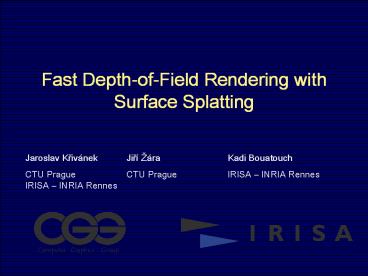Fast Depth-of-Field Rendering with Surface Splatting - PowerPoint PPT Presentation
1 / 25
Title:
Fast Depth-of-Field Rendering with Surface Splatting
Description:
Fast Depth-of-Field Rendering with Surface Splatting Jaroslav K iv nek CTU Prague IRISA INRIA Rennes Ji ra CTU Prague Kadi Bouatouch – PowerPoint PPT presentation
Number of Views:123
Avg rating:3.0/5.0
Title: Fast Depth-of-Field Rendering with Surface Splatting
1
Fast Depth-of-Field Rendering with Surface
Splatting
Jaroslav Krivánek CTU PragueIRISA INRIA Rennes
Jirí Žára CTU Prague
Kadi Bouatouch IRISA INRIA Rennes
Computer
Graphics
Group
2
Goal
- Depth-of-field rendering with point-based objects
- Why point-based ?
- Efficient for complex objects
- Why depth-of-field ?
- Nice and naturally looking images
3
Overview
- Introduction
- Point-based rendering
- Depth-of-field
- Depth-of-field techniques
- Our contribution Point-based depth-of-field
rendering - Basic approach
- Extended method depth-of-field with level of
detail - Results
- Discussion
- Conclusions
4
Point-based rendering
- Object represented by points without connectivity
- Point (surfel)
- position, normal, radius, material
- Rendering screen space surface reconstruction
- Efficient for very complex objects
5
Depth-of-Field
- More naturally looking images
- Important depth cue for perception of scene
configuration - Draws attention to the focused objects
6
Thin Lens Camera Model
VP
P
F/n
image plane
focal plane
lens
7
Depth-of-Field Techniques in CG
- Supersampling
- Distributed ray tracing Cook et al. 1984
- Sample the light paths through the lens
- Multisampling Haeberli Akeley 1990
- Several images from different viewpoints on the
lens - Average the resulting images using accumulation
buffer
8
Depth of Field Techniques in CG
- Post-filtering Potmesil Chakravarty 1981
- Out-of-focus pixels displayed as CoC
- Intensity leakage, hypo-intensity
- Slow for larger kernels
Focus processor(filtering)
Image synthesizer
9
Point-based rendering - splatting
- Draw each point as a fuzzy splat (an ellipse)
Image ? SPLATi
10
Our Basic Approach
- Post-filtering
Focus processor(filtering)
Image with DOF
?i SPLATi depth
Image depth
Image ?i SPLATi
11
Our Basic Approach
12
Properties of our basic approach
- PROS
- Avoids leakage
- Reconstruction takes into account the splat depth
- No hypo-intensities
- Visibility resolved after blurring
- Handles transparency
- In the same way as the EWA splatting A-buffer
- CONS
- - Very slow, especially for large apertures
- A lot of large overlapping splats
- High number of fragments
- E.g. Lion, no blur 2.3 mil. blur 90.2 mil.
(40x more)
13
Our Extended Method
- Use Level of Detail (LOD) to attack complexity
- blur detail
- Select lower LOD for blurred parts
- of fragments increases more slowly
- E.g. Lion, no blur 2.3 mil. blur 5.3 mil.
(2.3x more)
Blurred img.
Selected LOD
14
Observation
- Selecting lower LOD for rendering equivalent to
1) selecting the fine LOD 2)
low-pass filtering is screen space - Use LOD as a means for blurring
- not only to reduce complexity
Fine LOD
Lower LOD
15
Effect of LOD Selection
- How to quantify the effect of LOD selection in
terms of blur in the resulting image ? - We use Bounding sphere hierarchy
- Qsplat Rusinkiewicz Levoy, 2000
16
Bounding Sphere Hierarchy
- Building the hierarchy levels
low-pass filtering subsampling
The finest level L0
Lower level L1
17
LOD Filter in Screen Space
- GQL defined in local coordinates in object space
- GQL related to screen space by the local affine
approximation J of the object-to-screen transform - Selecting level L filtering in screen space by
GJQLJT
GQL
GJQLJT
Screen space
Object space
18
DOF with LOD - Algorithm
- Given the required screen space filter GQDOF
- Select LOD L such that support(
GJQLJT ) lt support ( r ? GQDOF ) - Apply an additional screen space filter GQDIFF to
get GQDOF
rDOF r ? GJQLJT ? GQDIFF
19
Results
No Depth-of-Field everything in focus
20
Results
Transparent mask in focus, male figure out of
focus
21
Results
Male figure in focus, transparent mask out of
focus
22
Results
Reference solution (multisampling)
Our algorithm
- Our blur looks too smooth because of the
Gaussian filter
23
Results
Reference solution (multisampling)
Our algorithm
- Artifacts due to incorrect surface
reconstruction
24
Discussion
- Simplifying assumptions limitations
- Gaussian distribution of light within the CoC
- Mostly ok
- We are blurring the texture before lighting
- We should blur after lighting
- Possible incorrect image reconstruction from
blurred splats
25
Conclusion
- A novel algorithm for depth of field rendering
- LOD as a means for depth-blurring
- Transparency
- Avoids intensity leakage
- Running time independent of the DOF
- - Only for point based rendering
- - A number of artifacts can appear
- Ideal tool for interactive DOF previewing
- Trial and error camera parameters setting
Acknowledgement Grant 2159/2002 MSMT Czech
Republic































